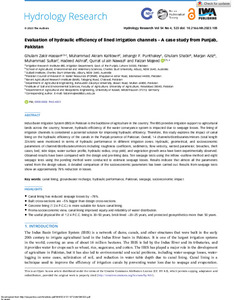Evaluation of hydraulic efficiency of lined irrigation channels - A case study from Punjab, Pakistan
| dc.date.accessioned | 2023-05-05T09:45:00Z | |
| dc.date.available | 2023-05-05T09:45:00Z | |
| dc.date.issued | 2023-04-04 | |
| dc.identifier | doi:10.17170/kobra-202305057943 | |
| dc.identifier.uri | http://hdl.handle.net/123456789/14658 | |
| dc.description.sponsorship | Gefördert durch den Publikationsfonds der Universität Kassel | ger |
| dc.language.iso | eng | |
| dc.rights | Namensnennung 4.0 International | * |
| dc.rights.uri | http://creativecommons.org/licenses/by/4.0/ | * |
| dc.subject | canal lining | eng |
| dc.subject | groundwater recharge | eng |
| dc.subject | hydraulic performance | eng |
| dc.subject | Pakistan | eng |
| dc.subject | seepage | eng |
| dc.subject | socioeconomic impact | eng |
| dc.subject.ddc | 620 | |
| dc.title | Evaluation of hydraulic efficiency of lined irrigation channels - A case study from Punjab, Pakistan | eng |
| dc.type | Aufsatz | |
| dcterms.abstract | Indus Basin Irrigation System (IBIS) in Pakistan is the backbone of agriculture in the country. The IBIS provides irrigation support to agricultural lands across the country; however, hydraulic efficiency of the water conveyance system is impacted due to seepage losses. The lining of irrigation channels is considered a potential solution for improving hydraulic efficiency. Therefore, this study explores the impact of canal lining on the hydraulic efficiency of the canals in the Punjab province of Pakistan. Overall, 14 channels/distributaries/minors (total length 226 km) were monitored in terms of hydraulic performance in different irrigation zones. Hydraulic, geometrical, and socioeconomic parameters of channel/distributaries/minors including roughness coefficient, sediments, flow velocity, wetted parameter, breaches, theft cases, bed, side slope, water surface profile, hydraulic radius, crop yield, and vegetation growth area have been experimentally observed. Obtained results have been compared with the design and pre-lining data. Ten seepage tests using the inflow -outflow method and eight seepage tests using the ponding method were conducted to estimate seepage losses. Results indicate that almost all the parameters varied from the design values. A detailed comparison of the socioeconomic parameters has been carried out. Results from seepage tests show an approximately 78% reduction in losses. | eng |
| dcterms.accessRights | open access | |
| dcterms.creator | Zakir-Hassana, Ghulam | |
| dcterms.creator | Akram Kahlownd, Muhammad | |
| dcterms.creator | Punthakey, Jehangir F. | |
| dcterms.creator | Shabira, Ghulam | |
| dcterms.creator | Azize, Marjan | |
| dcterms.creator | Sultanf, Muhammad | |
| dcterms.creator | Ashraff, Hadeed | |
| dcterms.creator | Nawazg, Qurrat ul ain | |
| dcterms.creator | Majeed, Faizan | |
| dcterms.extent | 523-546 | |
| dc.relation.doi | doi:10.2166/nh.2023.105 | |
| dc.subject.swd | Pakistan | ger |
| dc.subject.swd | Indus | ger |
| dc.subject.swd | Versickerung | ger |
| dc.subject.swd | Grundwasseranreicherung | ger |
| dc.subject.swd | Hydraulik | ger |
| dc.subject.swd | Sozioökonomischer Wandel | ger |
| dc.subject.swd | Bewässerungssystem | ger |
| dc.type.version | publishedVersion | |
| dcterms.source.identifier | eissn:2224-7955 | |
| dcterms.source.issue | Issue 4 | |
| dcterms.source.journal | Hydrology Research | eng |
| dcterms.source.volume | Volume 54 | |
| kup.iskup | false |
Dateien zu dieser Ressource
Das Dokument erscheint in:
-
Artikel [1186]


